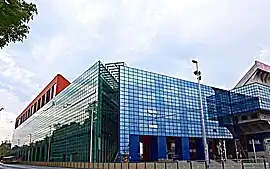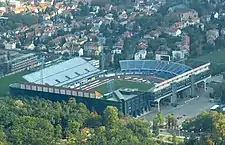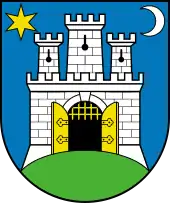Stadion Maksimir
Maksimir Stadium (Croatian: Stadion Maksimir, pronounced [ˈstâdioːn mǎksimiːr]) is a multi-use stadium in Zagreb, Croatia. Named after the surrounding neighbourhood of Maksimir, it is one of the largest stadiums in the country with a current seating capacity of 25,912 and a maximum possible capacity of 35,423. It is the home stadium of Croatian club Dinamo Zagreb and has been used since 1990 by the Croatia national football team for the majority of international competitions.
 Exterior view of the stadium, 2006 | |
| Full name | Maksimir Stadium |
|---|---|
| Location | Maksimir, Zagreb, Croatia |
| Coordinates | 45°49′7.89″N 16°1′5.08″E |
| Owner | City of Zagreb |
| Operator | Dinamo Zagreb |
| Capacity | 25,912 (interim)[1] |
| Record attendance | 64,138 (NK Zagreb vs Osijek, 19 July 1973) |
| Field size | 105 m × 68 m (344 ft × 223 ft) |
| Surface | Hybrid grass |
| Construction | |
| Opened | 5 May 1912 |
| Renovated | 1948, 1998, 2011 |
| Architect | Vladimir Turina, Branko Kincl |
| Tenants | |
| HAŠK (1912–1945) HŠK Građanski (1912–1924) Dinamo Zagreb (1948–present) ŽNK Dinamo Zagreb (selected matches) Croatia national football team (1990–present) NK Lokomotiva (2009–2017) | |
Built 111 years ago in 1912, the stadium underwent renovations in 1948, 1998, and 2011. Its facilities can be converted into a concert stage which has been used to host musical acts.
History
The construction and the early years
With the rising popularity of the sport in Zagreb, the local football club HAŠK, which was one of the first multi-sports club in Croatia, decided to build a new stadium for their club. They bought the ground in the Svetice neighbourhood in Zagreb, which lies on the opposite side of the Maksimir Park, from the Archdiocese of Zagreb. HAŠK built a wooden stand with a capacity of 6,000, which was also the first ground with a proper stand in Zagreb at that time. The stadium was opened on 5 May 1912, and at the opening ceremony of the new stadium, HAŠK and their city rival, HŠK Građanski Zagreb, played several friendly matches to commemorate the opening.[2] Due to the close relationship and alliance of HAŠK and HŠK Građanski Zagreb and the latter one playing at the Stadion Koturaška, which was in a poor state, Građanski also started playing their home matches at the new Stadium Maksimir.
On 26 May 1941, a representative of the Ustashe fascist government of the Independent State of Croatia addressed young Zagreb students at their meeting at the Maksimir Stadium, and at one point ordered the Serbian and Jewish students to be segregated, but the children disobeyed.[3][4] Soon afterwards, in June 1941, rebel youths burned the stadium down.[4] In 1977, a movie Operation Stadium was made to commemorate the segregation incident.
After World War II and the development
After World War II, HAŠK and Građanski got dissolved by the newly established communist regime of Yugoslavia and a new club, FD Dinamo Zagreb, inherited the clubs' colours, honours and the ground and is, therefore, the direct successor of HAŠK and HŠK Građanski Zagreb. When the UEFA Euro 1976 final tournament was held in Yugoslavia, Maksimir hosted the Netherlands v. Czechoslovakia semi-final match and the Netherlands v. Yugoslavia third place match. Maksimir was the central venue for the 1987 Summer Universiade hosted by the city of Zagreb.
In 1990, several events happened at Maksimir. On 13 May, the Dinamo Zagreb–Red Star Belgrade riot took place, an infamous riot involving Dinamo Zagreb and Red Star Belgrade supporters. The last match of the Yugoslavia national football team was hosted at Maksimir on 3 June. On 17 October of the same year, Croatia played the United States in what was Croatia's first match in the modern era.
In modern times
In 1998, plans were made for a massive renovation, and the first phase started the same year. The old northern stand was demolished and a new one built within a year. This renovation increased Maksimir's seating capacity to 38,079. After 1992, for 16 years the Croatian football team had a proud unbeaten record at this stadium in any competitive match, however, on 10 September 2008 (two years after suffering a 2–0 defeat at the same venue) England became the first team to beat Croatia in Zagreb, winning 4–1, ending a thirty match undefeated streak.
In the summer of 2011, a little, but much needed "facelifting" was made on the stadium. All seats were replaced, a new drainage system, under-soil heating and automatic watering were installed along with a new turf, the athletic track was covered with blue artificial grass and all brick surfaces were covered in blue cloth.
2020 earthquake
The earthquake, which happened on the morning of 22 March 2020, damaged the structural stability of the stadium. After an inspection by a structural engineer, the Maksimir stadium was deemed "temporarily unusable". The eastern stand, which is also the biggest single stand by capacity, took the most damage and is awaiting the final decision following a detailed building inspection. While waiting, the club is allowed to host matches on the Maksimir stadium, but with the eastern stand being closed for viewers.[5]
In August 2023, Maksimir was ranked the third ugliest football stadium in Europe according to research carried out by the Money agency based on reviews on platforms such as Google, TripAdvisor and Football Ground.[6]
Capacity per sector
Four stands (8 sectors) contribute to the total seating capacity of 35,423:[1] 25,912 with the East stand closed.
.jpg.webp)
- North stand (up): 4,510
- North stand (down): 4,950
- North stand (VIP): 300
- West stand (up): 5,101
- West stand (down): 6,369
- West stand (VIP): 748
- East stand: 9,514 – temporarily closed due to earthquake damage
- South stand: 3,931
International matches
Concerts
The stadium has also been used as the venue for some big concerts, including:
- On 5 September 1990, David Bowie performed a sold-out concert as a part of his Sound+Vision Tour (1990).
- In 2000, Zlatan Stipišić Gibonni performed a concert in front of 32,000 people, promoting his album Judi, zviri i beštimje (2000).
- On 22 June 2005, Bijelo Dugme performed a reunion concert for a crowd of 70,000 people on their Tour 2005. (2005).
- On 17 June 2007, Marko Perković Thompson performed a concert for a crowd of 70,000 people as a part of his Bilo jednom u Hrvatskoj Tour (2007).
- On 9 and 10 August 2009, U2 performed two sold-out concerts for 124,012 people as a part of their U2 360° Tour (2009-2011).
- On 8 June 2011, Bon Jovi performed a concert for a crowd of 33,698 people as a part of their Bon Jovi Live Tour, which supports the band's sixth compilation album, The Greatest Hits. (2011).
- On 11 June 2012, Madonna was scheduled to perform a concert as a part of her MDNA Tour, but the concert was cancelled due to logistic reasons.
- On 23 May 2013, Depeche Mode was scheduled to perform a concert as a part of their Delta Machine Tour, but the concert was changed to the Arena Zagreb due to logistic reasons.
- On 13 August 2013, Robbie Williams performed a concert in front of 45,000 people, featuring Olly Murs as his opening act, as a part of Take the Crown Stadium Tour (2013).
Renovation plans

The 1998 renovations plans included lowering the pitch and adding seating where the current running track is, gaining 16,000 seats. The plans also included the addition of a modern roof structure. Maksimir was to have a capacity of 60,000 and was to be an exclusively football stadium.[7] However, in the beginning of the 2000s, the renovations were suspended.
In 2008, the Zagreb city government presented two potential stadiums; Project Maksimir at the current location and Project Vulkan (Volcano), which was proposed for the Kajzerica neighbourhood. The two proposals were to go to a citizens vote, however, little progress was made.
Kajzerica Proposal

The design competition for the new stadium was won by architect Hrvoje Njirić in May 2008.[8] The winning design, nicknamed "Blue Volcano" (Croatian: Plavi vulkan), would have a capacity of 55,000 and would include a blue-coloured polycarbonate dome exterior and a cloud-like structure suspended above the stadium covered in photovoltaic panels.[9]
The referendum about the proposal, which had originally been scheduled for June 2008, was postponed several times since and has not been held. In October 2012, the project was abandoned,[10] to be briefly revived in 2013 with an eye to a possible UEFA Euro 2020 bid,[11] and again in 2018, following Croatia's historic success in the World Cup.[12]
Recent Plans
There were talks in 2018 that the stadium was going to be demolished and a new, state-of-the-art stadium would be built on the same location. In 2019, Dinamo Zagreb announced that it will demolish Maksimir and build a new stadium on its own, without the help of the Croatian Government, but needed confirmation from the governing body of Zagreb and its mayor, Milan Bandić. Shortly after, it was announced that Dinamo Zagreb and the City of Zagreb will enter a joint collaboration to build the new stadium. The new stadium was supposed to be built on the ground of the current Maksimir Stadium and have had a capacity of 30,000 spectators. The stadium would have had a garage, shopping centre, hotel and several fan corners. After the 2020 Zagreb earthquake, the talks were, once again, put on hold.
Between 1997 and 2015, a total of HRK 800 million (c. €108 million) has been spent renovating the stadium.[13]
As of October 2022, Marko Milić of the Croatian government, has guaranteed that there will be a new Maksimir built with help of the government and the city of Zagreb.
In June 2023, the Mayor of Zagreb Tomislav Tomašević announced plans to reconstruct Stadion Kranjčevićeva, the second major stadium of Zagreb. The plans included the increase of the stadium capacity to 12,000 seats with a total remodelling of all four stands.[14] At the unveiling of the plans, Tomašević said that the plan was for Dinamo Zagreb to leave Maksimir and play out of Kranjčevićeva on completion in 2025 so that the old stadium at Maksimir can be demolished and a new stadium built in its place.
In July 2023, the two major football stadiums in Croatia, Maksimir and Poljud were declared sports buildings of national interest by the Croatian Government.[15] The decision was said to confirm the government's intention to construct a new stadium in Maksimir and complete significant renovations to Poljud.
References
- "Stadion - Dinamo Zagreb". gnkdinamo.hr. Archived from the original on 30 July 2017. Retrieved 9 May 2018.
- "Nogometno ime Zagreb kroz povijest/The Zagreb name through football history". nkzagreb041.hr. Retrieved 16 February 2021.
- Zuroff, Efraim (2007-06-25). "Ustasa rock n' roll". Jerusalem Post. Archived from the original on 2012-10-23. Retrieved 2012-04-24.
- Svjetlana Zorić (2010-05-12). "Otkrivanje nepoznatog Zagreba". E-novine (in Croatian). Archived from the original on 2012-11-19. Retrieved 2012-04-24.
- "Stadion Maksimir privremeno neupotrebljiv, dobio žutu oznaku. Urušava se godinama". index.hr. Retrieved 16 February 2021.
- Simmonds, Lauren (2023-08-12). "Maksimir Stadium Ranked Third Ugliest in Europe". Total Croatia. Retrieved 2023-09-25.
- "STADIUM MAKSIMIR, basic". Archived from the original on 2007-10-19. Retrieved 2009-07-19.
- Blašković, Boba; Milković, Ante (2 May 2008). "Novi Dinamov stadion: Plavi vulkan". Jutarnji list (in Croatian). Archived from the original on 19 September 2010. Retrieved 17 August 2010.
- Schwartz, Ariel (5 January 2010). "Blue Volcano: A Futuristic Cloud-Covered Stadium for Croatia". Fast Company. Archived from the original on 28 May 2010. Retrieved 17 August 2010.
- Brkulj, Vedran (17 October 2012). "Bandić odustao od rekonstrukcije Maksimira i gradnje Kajzerice". tportal.hr (in Croatian). Archived from the original on 18 March 2014. Retrieved 17 October 2012.
- "GDJE ĆE SE GRADITI NACIONALNI STADION 'Plavi vulkan' na Kajzerici stajat će 122 milijuna eura". Jutarnji list (in Croatian). 21 September 2013. Archived from the original on 5 August 2017. Retrieved 4 August 2017.
- "Jutarnji list - FOTO: OVAKO BI TREBAO IZGLEDATI 'PLAVI VULKAN', NOVI HRVATSKI NACIONALNI STADION Koštao bi 120 milijuna eura, a većinu novca dao bi Grad Zagreb". 14 July 2018.
- "Zašto izgradnja krova na dvije tribine Maksimira košta kao bolji stadion". telegram.hr (in Croatian). 2 December 2015. Retrieved 16 November 2018.
- "PHOTOS: New modern Zagreb stadium in Kranjčevićeva street presented". Croatia Week. 2023-06-08. Retrieved 2023-07-19.
- Rogulj, Daniela (2023-07-06). "Maksimir and Poljud Stadiums Declared Sports Buildings of National Interest". Total Croatia. Retrieved 2023-07-19.
